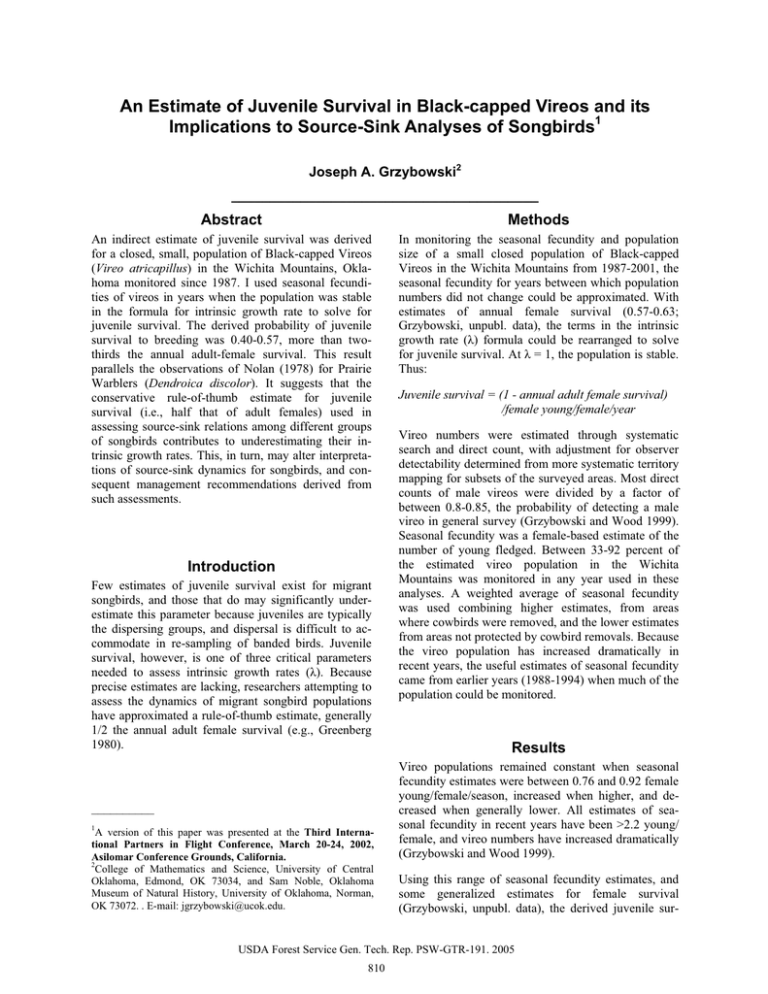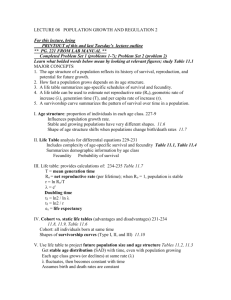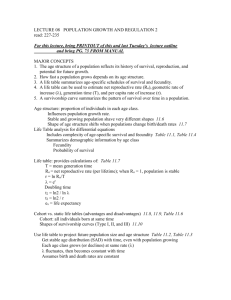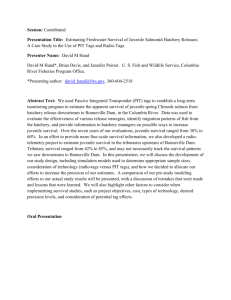An Estimate of Juvenile Survival in Black-capped Vireos and its
advertisement

An Estimate of Juvenile Survival in Black-capped Vireos and its Implications to Source-Sink Analyses of Songbirds1 Joseph A. Grzybowski2 ________________________________________ Abstract Methods An indirect estimate of juvenile survival was derived for a closed, small, population of Black-capped Vireos (Vireo atricapillus) in the Wichita Mountains, Oklahoma monitored since 1987. I used seasonal fecundities of vireos in years when the population was stable in the formula for intrinsic growth rate to solve for juvenile survival. The derived probability of juvenile survival to breeding was 0.40-0.57, more than twothirds the annual adult-female survival. This result parallels the observations of Nolan (1978) for Prairie Warblers (Dendroica discolor). It suggests that the conservative rule-of-thumb estimate for juvenile survival (i.e., half that of adult females) used in assessing source-sink relations among different groups of songbirds contributes to underestimating their intrinsic growth rates. This, in turn, may alter interpretations of source-sink dynamics for songbirds, and consequent management recommendations derived from such assessments. In monitoring the seasonal fecundity and population size of a small closed population of Black-capped Vireos in the Wichita Mountains from 1987-2001, the seasonal fecundity for years between which population numbers did not change could be approximated. With estimates of annual female survival (0.57-0.63; Grzybowski, unpubl. data), the terms in the intrinsic growth rate (Ȝ) formula could be rearranged to solve for juvenile survival. At Ȝ = 1, the population is stable. Thus: Introduction Few estimates of juvenile survival exist for migrant songbirds, and those that do may significantly underestimate this parameter because juveniles are typically the dispersing groups, and dispersal is difficult to accommodate in re-sampling of banded birds. Juvenile survival, however, is one of three critical parameters needed to assess intrinsic growth rates (Ȝ). Because precise estimates are lacking, researchers attempting to assess the dynamics of migrant songbird populations have approximated a rule-of-thumb estimate, generally 1/2 the annual adult female survival (e.g., Greenberg 1980). __________ 1 A version of this paper was presented at the Third International Partners in Flight Conference, March 20-24, 2002, Asilomar Conference Grounds, California. 2 College of Mathematics and Science, University of Central Oklahoma, Edmond, OK 73034, and Sam Noble, Oklahoma Museum of Natural History, University of Oklahoma, Norman, OK 73072. . E-mail: jgrzybowski@ucok.edu. Juvenile survival = (1 - annual adult female survival) /female young/female/year Vireo numbers were estimated through systematic search and direct count, with adjustment for observer detectability determined from more systematic territory mapping for subsets of the surveyed areas. Most direct counts of male vireos were divided by a factor of between 0.8-0.85, the probability of detecting a male vireo in general survey (Grzybowski and Wood 1999). Seasonal fecundity was a female-based estimate of the number of young fledged. Between 33-92 percent of the estimated vireo population in the Wichita Mountains was monitored in any year used in these analyses. A weighted average of seasonal fecundity was used combining higher estimates, from areas where cowbirds were removed, and the lower estimates from areas not protected by cowbird removals. Because the vireo population has increased dramatically in recent years, the useful estimates of seasonal fecundity came from earlier years (1988-1994) when much of the population could be monitored. Results Vireo populations remained constant when seasonal fecundity estimates were between 0.76 and 0.92 female young/female/season, increased when higher, and decreased when generally lower. All estimates of seasonal fecundity in recent years have been >2.2 young/ female, and vireo numbers have increased dramatically (Grzybowski and Wood 1999). Using this range of seasonal fecundity estimates, and some generalized estimates for female survival (Grzybowski, unpubl. data), the derived juvenile sur- USDA Forest Service Gen. Tech. Rep. PSW-GTR-191. 2005 810 Juvenile Survival and Source-Sink Analyses - Grzybowski vival to breeding was 0.40-0.57 (table 1). These values are very sensitive to the estimation of female survival. Table 1— Estimates of juvenile survival under two estimates of female survival. Range Median Female survival = 0.57 0.48 - 0.57 0.51 Female survival = 0.63 0.40 - 0.49 0.44 Discussion The lower estimate of juvenile survival from this analysis is still greater than two-thirds that of adult females, and much higher than the standard rule-ofthumb that is usually applied by other researchers in some population-modeling efforts (Greenburg 1980, Donovan et al. 1995). This level of juvenile survival for the Black-capped Vireo, a species that maintains a high level of parental investment, may be higher than that of some species. However, it parallels an estimate of Nolan (1978) for Prairie Warblers (>0.39), another Neotropical migrant, and suggests that analyses assuming lower values are overly conservative, and will result in lower estimates of intrinsic growth rates. table 2 contrasts the estimates of intrinsic growth rates (Ȝ) for several studies with adjustments made for (1) the potential underestimation bias for juvenile survival and (2) additional biases by researchers in estimating seasonal fecundity (see Grzybowski and Pease unpubl. data, and below). Nolan (1978) derived an empirical estimate for juvenile survival he felt was conservative. Donovan et al. (1995) use the previously accepted assumption whereby juvenile survival (to first breeding) is approximately 1/2 annual adult female survival. The uncertainties of parameter estimation led Donovan et al. to develop a range under varying estimates of female survivorship. Median values were used in table 2. Ward and Smith (2000) assumed juvenile survival was the same as adult female survival, and also assumed only one nesting attempt per female per season. Both assumptions are quite arbitrary and reflects their limited sampling of Warbling Vireo nesting effort. table 2 also depicts adjustments made for potential biases in converting nest history data to estimates of seasonal fecundity under assumptions fixing the maximum number of nesting attempts (see Pease and Grzybowski 1995; Grzybowski and Pease 2000, unpubl. data; Farnsworth and Simon, pers. comm.). Quite clearly, intrinsic growth rates are lower under previous assumptions, substantially so in some cases. Table 2— Estimates of O under assumptions and estimations of Donovan et al. (1995) or Ward and Smith (2000), and those herein (see text). Previous estimates of O are recalculated as: O = ad. female survival + [(seasonal fecundity X 0.9) (ad. female survival X 0.67] where nest mortality is low, and ... O = ad. female survival + [(seasonal fecundity X 1.22) (ad. female survival X 0.67] where nest mortality is high (Grzybowski and Pease unpubl. data). Species Wood Thrush Red-eyed Vireo Warbling Vireo Ovenbird Sitea MO MO WI/MN WI/MN MO MO WI/MN WI/MN BC MO MO WI/MN WI/MN Treatmentb Frag Cont Frag Cont Frag Cont Frag Cont Ripar Frag Cont Frag Cont Adult female survival 0.67 0.67 0.67 0.67 0.56 0.56 0.56 0.56 0.50c 0.62 0.62 0.62 0.62 Published fecundity estimate 0.85 1.75 1.12 2.40 0.00 1.46 0.63 2.00 0.708d 0.74 1.32 0.59 1.35 a Published or derived Ȝ 0.93 1.21 1.02 1.41 0.56 1.01 0.76 1.18 0.854 0.85 1.03 0.80 1.04 Revised estimate of Ȝ 1.14 1.38 1.28 1.64 NRe 1.05 0.85 1.23 1.10 1.00 1.11 0.92 1.12 MO = Missouri; WI = Wisconsin; MN = Minnesota; BC = British Columbia Frag = Fragmented forest patch; Cont = Continuous Forest tract; Ripar = riparian woodland 0.57 used in re-estimation d probability of nest success first extended out to the sums of up to three nesting attempts (to make comparable with those of Donovan et al. 1995) e Not re-estimated; original observation based on sample of 2 nestings b c USDA Forest Service Gen. Tech. Rep. PSW-GTR-191. 2005 811 Juvenile Survival and Source-Sink Analyses - Grzybowski Management Implications A developing paradigm is that some populations of songbirds in fragmented habitats, or habitats that are subject to high levels of nest predation or parasitism by cowbirds, have such low nest success that their persistence is maintained by long-distance immigration (Faaborg et al. 1998). A consequent management recommendation is that songbird populations so threatened will only be maintained by such immigration from source populations in large reserves, or continuous blocks of suitable habitat. An alternative hypothesis, not heretofore considered, is that the low intrinsic growth rates estimated are consequences of the assumptions used to calculate them, rather than a result largely of biological processes. Some populations in these fragmented landscapes may actually be maintaining their numbers, while others may be marginalized only slightly below the reproductive success needed to maintain stable numbers. These populations, in fact, may be declining slowly. This seems to be a more parsimonious explanation of the current maintenance of populations in many fragmented Midwestern habitats, rather than the current belief in maintenance from long-distance immigration. Because the ability of long-distance immigration to maintain distant populations still has no empirical support, and may not be occurring to any significant extent, more locally-focused management strategies need more serious consideration in allowing songbird populations radically affected by nest mortality to persevere into the future. Acknowledgments I fear assembling this list, as help came from so many quarters over the course of many years. Access to the Wichita Mountains Wildlife Refuge and Fort Sill Military Reservation, facility use, and various levels of internal support came from B. Karges, S. Smith, S. Waldstein, J. Crabtree, J. and C. Kimball, D. Bartush, J. Gallagher, T. Hodgkins, G. Stout, E. J. Ardoin, D. Tazik, and G. Wampler. Funding came through the Oklahoma Department of Wildlife Conservation, (Nongame Program), Ecological Services Office of the U.S. Fish and Wildlife Service in Tulsa, Wichita Mountains Wildlife Refuge, and U.S. Army. Instrumental in these has been B. Moser, C. Wallace, H. Namminga, J. Skeen and M. Howery. Administrative support from the University of Central Oklahoma was provided by B. Beall, J. Cage, K. Curl, J. Foley, C. Jacob, D. Koehn, J. Perry, J. Mounce, N. Rao, and S. Wagnon. Field Assistants helping in various aspects of the work were P. Ashman, D. Base, V. Bell, J. Bowser, D. and K. Brubaker, C. Buckley, V. Byre, D. Ely, D. Farrell, V. Fazio III, B. Gall, B. Griffin, S. Hull, R. Hylton, T. James, E. and J. Keys, D. Ladd, L. McGee, K. Moholt, R. Moore, E. Munson, J. Parrish, T. Poitras, M. Quinn, P. Shaw, M. Stake, B. and D. St. George, D. Wagner, T. Westmoreland, and R. Wood. C. J. Ralph provided comments useful in improving this manuscript. Literature Cited Donovan, T. M., F. R. Thompson, III, J. Faaborg, and J. R. Probst. 1995. Reproduction success of migratory birds in habitat sources and sinks. Conservation Biology 9: 13801395. Faaborg, J., F. R. Thompson III, S. K. Robinson, T. M. Donovan, D. R. Whitehead, and J. D. Brawn. 1998. Understanding fragmented Midwestern landscapes: The future. In: J. M. Marzluff and R. Sallabanks, editors. Avian conservation: Research and management. Washington DC: Island Press; 193-207. Greenberg, R. 1980. Demographic aspects of long-distance migration. In: A. Keast and E. S. Morton, editors. Migrant birds in the Neotropics: Ecology, behavior, distribution, and conservation. Washington, DC: Smithsonian Institution Press; 493-504. Grzybowski, J. A. and C. M. Pease. 2000. Comparing the relative effects of nest predation and brood parasitism on seasonal fecundity in passerine birds. In: J. N. M. Smith, T. L. Cook, S. K. Robinson, S. I. Rothstein, and S. G. Sealy, editors. The ecology and management of cowbirds and their hosts. Austin, TX: University of Texas Press; 145-155. Grzybowski, J. A. and R. Wood. 1999. Status report: Blackcapped Vireo in the Wichita Mountains Wildlife Refuge -- 1998. Report. Indiahoma, Oklahoma: Wichita Mountains Wildlife Refuge, Fish and Wildlife Service, U.S. Department of the Interior; 16p. Nolan, V., Jr. 1978. The ecology and behavior of the Prairie Warbler Dendroica discolor. Ornithological Monographs No. 26. Pease, C. M. and J. A. Grzybowski. 1995. Assessing the consequences of brood parasitism and nest predation on seasonal fecundity in passerine birds. Auk 112: 343-363. Ward, D. and J. N. M. Smith. 2000. Brown-headed Cowbird parasitism results in a sink population in Warbling Vireos. Auk 117: 337-344. USDA Forest Service Gen. Tech. Rep. PSW-GTR-191. 2005 812







